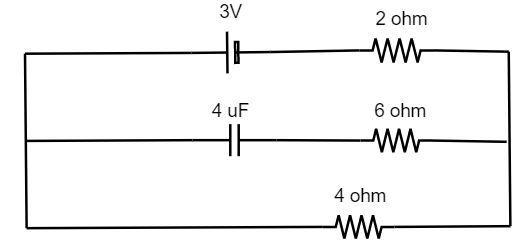
Find the potential drop across $4\,\mu F$ capacitor and $6\,\Omega $ resistor in figure.

(A) $0,\,0$
(B) $0,\,3V$
(C) $0,\,2V$
(D) $2V,\,0$
Answer
218.4k+ views
Hint Find the total current of the given circuit from the rearranged ohm’s law. Again substitute the value of the resistance and the calculated current in it to find the potential drop across the two branches with the capacitor and the $6\,\Omega $ resistor.
Useful formula:
The ohm’s law is given by
$V = IR$
Where $V$ is the potential difference, $I$ is the current and $R$ is the resistance developed in the circuit.
Complete step by step answer
From the given circuit diagram, it is understood that it possesses three branches with the capacitor at the middle branch. Let us use the formula of the ohm’s law,
$V = IR$
Let us find the total current through the circuit, by rearranging the above formula, we get
$I = \dfrac{V}{R}$
Let us consider that the capacitor is fully charged. Since it is fully charged, it will not draw any current from the total current. Hence the current through the branch of the capacitor is zero. Let us substitute this in the above formula, we get
$I = \dfrac{3}{{2 + 4}}$
By performing basic arithmetic operations, we get
$I = \dfrac{1}{2}\,A$
The potential drop across the $6\,\Omega $ resistor is found using the ohm’s law.
$V = IR = 0 \times 6$
$V = 0$
Hence the potential drop across the capacitor circuit is zero.
The potential drop across the $4\,\Omega $ resistor is calculated using the ohm’s law.
$V = \dfrac{1}{2} \times 4$
By simplification of the above step, we get
$V = 2\,V$
Hence the potential drop across the $4\,\Omega $ resistor is calculated as $2$ volt. Since the voltage drop across the parallel circuit is the same, the potential drop in the branch of $4\,\Omega $ resistor must be equal to that of the potential drop across the $4\,\mu F$ capacitor.
Thus the option (D) is correct.
Note: Remember that in the parallel circuit, the total current through the circuit will be equal to the sum of the current through the resistors. The voltage drop across each branch will be equal to the voltage drop across other branches and also the total voltage drop.
Useful formula:
The ohm’s law is given by
$V = IR$
Where $V$ is the potential difference, $I$ is the current and $R$ is the resistance developed in the circuit.
Complete step by step answer
From the given circuit diagram, it is understood that it possesses three branches with the capacitor at the middle branch. Let us use the formula of the ohm’s law,
$V = IR$
Let us find the total current through the circuit, by rearranging the above formula, we get
$I = \dfrac{V}{R}$
Let us consider that the capacitor is fully charged. Since it is fully charged, it will not draw any current from the total current. Hence the current through the branch of the capacitor is zero. Let us substitute this in the above formula, we get
$I = \dfrac{3}{{2 + 4}}$
By performing basic arithmetic operations, we get
$I = \dfrac{1}{2}\,A$
The potential drop across the $6\,\Omega $ resistor is found using the ohm’s law.
$V = IR = 0 \times 6$
$V = 0$
Hence the potential drop across the capacitor circuit is zero.
The potential drop across the $4\,\Omega $ resistor is calculated using the ohm’s law.
$V = \dfrac{1}{2} \times 4$
By simplification of the above step, we get
$V = 2\,V$
Hence the potential drop across the $4\,\Omega $ resistor is calculated as $2$ volt. Since the voltage drop across the parallel circuit is the same, the potential drop in the branch of $4\,\Omega $ resistor must be equal to that of the potential drop across the $4\,\mu F$ capacitor.
Thus the option (D) is correct.
Note: Remember that in the parallel circuit, the total current through the circuit will be equal to the sum of the current through the resistors. The voltage drop across each branch will be equal to the voltage drop across other branches and also the total voltage drop.
Recently Updated Pages
A square frame of side 10 cm and a long straight wire class 12 physics JEE_Main

The work done in slowly moving an electron of charge class 12 physics JEE_Main

Two identical charged spheres suspended from a common class 12 physics JEE_Main

According to Bohrs theory the timeaveraged magnetic class 12 physics JEE_Main

ill in the blanks Pure tungsten has A Low resistivity class 12 physics JEE_Main

The value of the resistor RS needed in the DC voltage class 12 physics JEE_Main

Trending doubts
JEE Main 2026: Application Form Open, Exam Dates, Syllabus, Eligibility & Question Papers

Derivation of Equation of Trajectory Explained for Students

Hybridisation in Chemistry – Concept, Types & Applications

Understanding the Angle of Deviation in a Prism

Understanding Collisions: Types and Examples for Students

Understanding Atomic Structure for Beginners

Other Pages
JEE Advanced Marks vs Ranks 2025: Understanding Category-wise Qualifying Marks and Previous Year Cut-offs

How to Convert a Galvanometer into an Ammeter or Voltmeter

Understanding Centrifugal Force in Physics

JEE Main Marking Scheme 2026- Paper-Wise Marks Distribution and Negative Marking Details

Degree of Dissociation: Meaning, Formula, Calculation & Uses

Understanding Electromagnetic Waves and Their Importance




